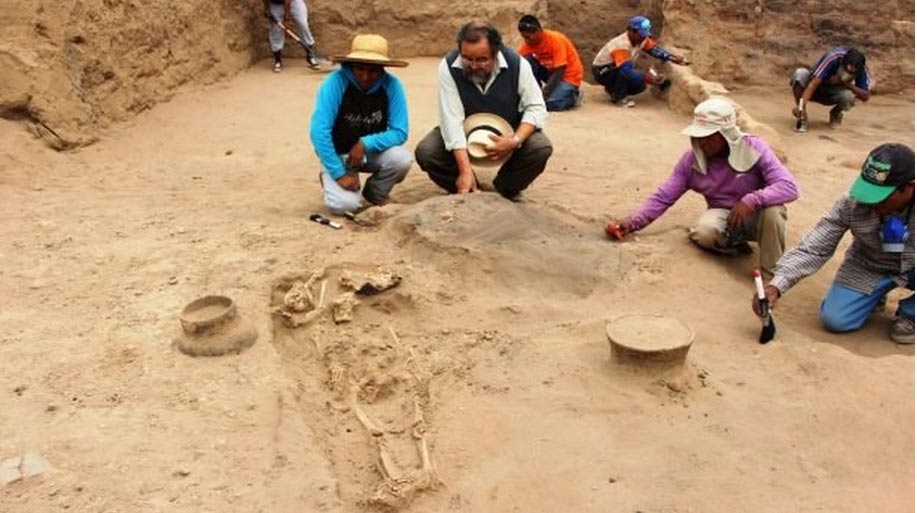4,000-Year-Old Mochica Temple and Tombs Unearthed in Peru
A 4,000-year-old temple and tombs of 14 ancient Peruvians have been excavated at an ongoing archaeological dig in the Lambayeque area. The temple belongs to the mysterious Moche civilization, while the tombs are associated with the Sican or Lambayeque culture, as well as the Moche and Chimu civilizations, according to El Comercio.
Archaeologists Edgar Bracamonte Lévano and Walter Alva Alva found the 14 tombs and valuable artifacts at Bola de Oro-El Triunfo.
Items found in a Lambayeque tomb include a gold piece that was used to remove hair. “The gold piece was made with a representation of Naylamp and the traditional mask of winged eyes,” Peru This Week reported. “Other items include pottery, small copper ornaments, silver and gilded copper birds and other ceremonial items such as knives. … Of particular interest to Alva was the discovery of a Late Moche ceramic vessels fragment. Normally found in La Libertad, this indicates that the culture at Bola de Oro-El Triunfo had contact with the Moche culture.”
The Moche are particularly known for their sex-themed pottery, which is often very explicit in nature.
- The spectacular Mochican tomb complex of Huaca Rajada, Peru
- Tomb of Lord Sipan: Mochican warrior priest
- Sex pottery of Peru: Moche ceramics shed light on ancient sexuality

Sexually explicit ceramics of the Moche culture (public domain)
Naylamp, a deity, was considered the mythical founder of the Lambayeque culture in the 8 th century AD after the collapse of the Moche civilization. The Sican culture, as Lambayeque is also known, succeeded the Moche culture, with which they had some affinities.
In 1375 the Chimú culture conquered the Lambayeque people, who were known for their skillful irrigation works.
The Lambayeque also built large funerary complexes at Batan Grande. When the rulers of the people died, they were buried with the gold objects they had hoarded in life.
“Prodigious producers of art objects, masks, and goldwork, the Lambayeque made a significant contribution to the progression of Andean art and their legacy includes some of the most recognizable iconography from the ancient Americas,” says the website Ancient History Encyclopedia.

Naylamp, the mythical founder of the Layambeque or Sican culture, is shown on this vessel. (Wikimedia Commons)

Lambayeque funerary mask from the 9 th to 11 th centuries, found in a burial mound previous to the recent finds. (Photo by Rosemania/Wikimedia Commons)
Batán Grande (“Great Anvil”) in the La Leche Valley is one of the most important Sican sites. The people built a system of canals for irrigation and 17 huge pyramidal burial mounds. Huaca Corte burial mound covers 250 square meters (2,690 square feet). The mounds contained mummies, sacrificial victims and precious grave goods made from gold, silver and alloys of copper. Hundreds of gold cups with figures in relief have been found.
Climate change, flooding and droughts forced the people to abandon Batán Grande around 1100. The buildings show signs of arson, Ancient History Encyclopedia says.
They then went to Túcume to establish a religious capital, which became the largest ceremonial center in the prehistoric Andes at 370 hectares (1.43 square miles). The Valley of Túcume is one of the most important archaeological sites of Peru. It is near the city of Chiclayo and has 26 pyramids covering an area of around 220 hectares (0.85 mile) from the Lambayeque, Chimú and Inca cultures. People were active building at Túcume from the 11th to 15th century AD.

The Valley of Túcume, one of Peru's most important archaeological sites. (Photo by David Baggins/Wikimedia Commons)
Lambayeque metal was produced at Cerro Huaringa. There workshops and smelting furnaces were found. Archaeologists found copper I-shaped ingots that may have been used as currency between 900 and 1100 AD. Use of currency was rare in the Americas.
Scholars don't think the Lambayeque rulers attempted regional conquest. The Chimú empire defeated them and assimilated beginning about 1375 AD. Artisans were made to relocate to Chan Chan, capital of the Chimú. This propagated a continuity in Andean art.
Featured image: Researchers recently found 14 tombs dating back to pre-Inca times. (Credit: Wilfredo Sandoval).
By Mark Miller



















